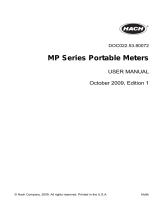Page is loading ...

COM-100 7/09
COM-100 USER’S GUIDE ADDENDUM
MODE SELECTION GUIDE
The COM-100 includes 6 different measurement modes allowing for a variety of uses and
greater versatility and accuracy.
The different modes serve to digitally calculate conductivity and TDS levels found in nature.
Since different applications will naturally involve different types of water (fresh water, brackish
water, salt water, etc.), proper mode selection is very important. Mode selection will also affect
accuracy within a particularly range. For certain applications, such as drinking water and water
treatment, a lower level of EC/TDS is typically preferred, while for other applications, such as for
fish and plants, a higher level of EC/TDS is preferred.
The following are suggested modes for various applications. Your specific needs may require a
different mode than what is listed below. If you are measuring liquids based on another
company’s instructions, then change the COM-100’s mode to those specific instructions. For
example, if you are mixing nutrients or fertilizer, and the instructions call for the NaCl scale in
TDS, switch the COM-100 to the ppm-NaCl mode.
ppm = TDS (Total Dissolved Solids)
µS = EC (Electrical Conductivity)
Drinking Water (Filtered or Tap): ppm-442 or ppm-NaCl
Filtration/Purification Systems: ppm-442 or ppm-NaCl
Hydroponics/Gardening: Consult fertilizer or nutrient requirements
Aquariums and Reef Tanks: ppm-NaCl or ppm-KCl
Colloidal Silver: ppm-NaCl or ppm442
Pools & Spas: ppm-NaCl
Car & Window Washing: ppm-442 or ppm-NaCl
Coffee: ppm-442 or ppm-NaCl
** For instructions on how to switch modes, see page 4 of the user’s guide.
ABOUT TDS and EC
Modes and their conversion factors
EC modes: There is no conversion for electrical conductivity. The three EC modes in the COM-
100 differ only in their ATC programs. The standard EC mode is KCl.
When converting EC to TDS, the COM-100 uses the non-linear scales, as they would occur in
nature, thereby giving you more accurate readings than meters that use linear scales.
TDS - NaCl: 0.47 to 0.50
TDS - 442: 0.65 to 0.85
TDS - KCl: 0.50 to 0.57
Converting between different scales
PPM
µS: Simply change the mode on the meter. There is no math required.
PPM
PPT: Divide by 1000 (1000 ppm = 1 ppt)
µS
mS: Divide by 1000 (1000 µS = 1 mS)
** For more information on TDS, visit www.tdsmeter.com.
FREQUENTLY ASKED QUESTIONS (FAQs)
What should the TDS of my water be?
A TDS level is specific for each application and particular usage. If you are using the COM-
100 to test the water pertaining to a particular device, object or operation, contact the
manufacturer of that object. For example, if you are using the COM-100 to test the efficacy of a
water filtration system, contact the manufacturer of that system for preferred TDS levels. If you
are testing the water for a pool, plants, fish, etc. contact a specialist for your specific application.
What is the difference between µS and µS/cm?
There is no difference between µS and µS/cm. µS is a simple abbreviation and is used to
save space.
What is the difference between ppm and mg/L?
ppm is an expression of quantity, and an abbreviation for “parts per million.” Mg/L (milligrams
per liter) is an expression of weight. Both are used as scales for TDS, but ppm is considerably
more popular. There is no conversion between the two. (226 ppm = 226 mg/L)
What is the difference between a parameter and a scale?
A parameter is the characteristic being measured. A scale is a particular range applied to the
measurement of that parameter. For example, temperature is a parameter. Fahrenheit or
Celsius is a scale.
Is “EC” a parameter or a scale?
“EC” is a parameter. It stands for Electrical Conductivity. There are a number of scales used
in EC, most commonly micro-Siemens (µS) or milli-Siemens (mS). For example, if a particular
application calls for water with “2.0 EC,” this is an incorrect determination. Most likely, the
application is calling for an EC level of 2.0 mS. 2.0 mS = 2000 µS.
Is the COM-100 waterproof?
Yes. Ensure the blue sensor gasket ring and blue battery compartment are screwed on
tightly.
TROUBLESHOOTING
Problem Potential Solution(s)
The meter will not power on. 1. Change the batteries.
2. Double-check the polarity of the batteries.
The display shows “---“. 1. The EC/TDS level of the water is out of range of the meter.
2. The sensor is not connected.
3. The sensor is dirty or damaged.
Incorrect readings. 1. Recalibrate the meter.
2. Switch modes.
For additional information on water testing, visit www.hmdigital.com.
®
HM Digital, Inc.
/

